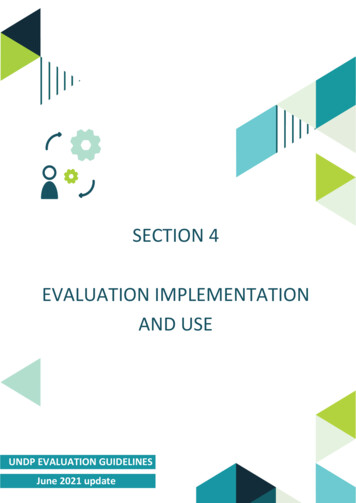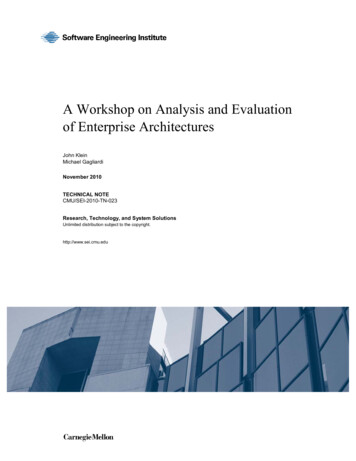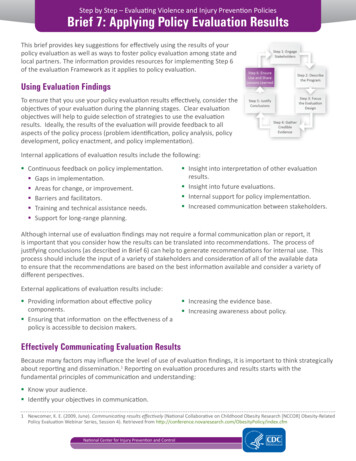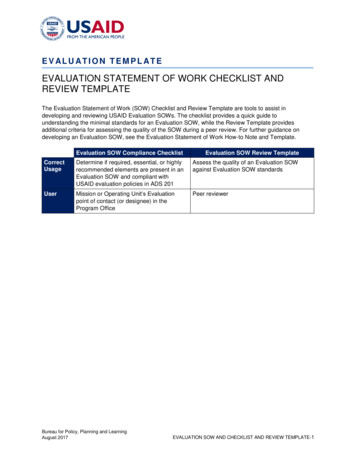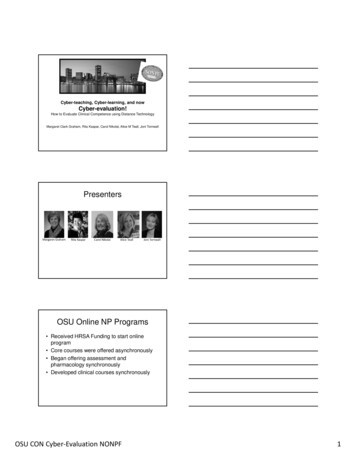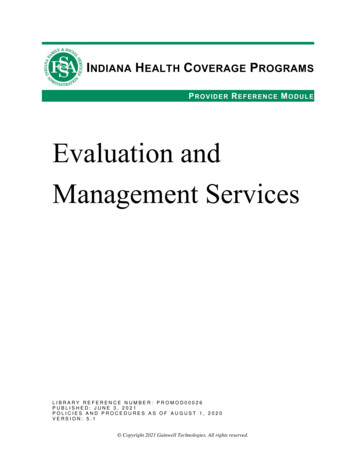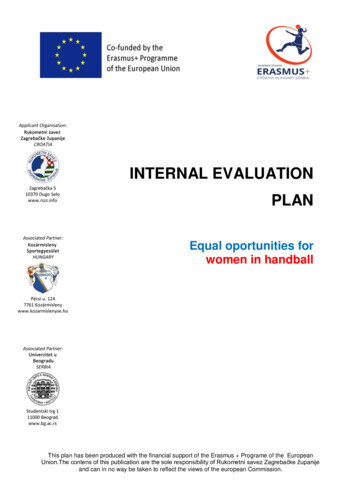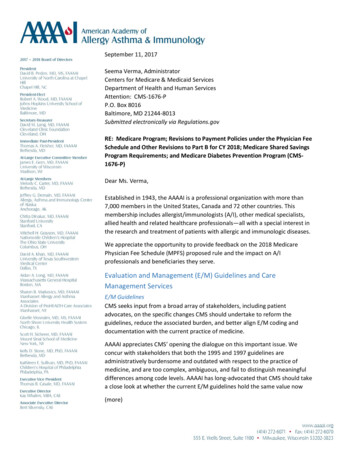
Transcription
September 11, 2017Seema Verma, AdministratorCenters for Medicare & Medicaid ServicesDepartment of Health and Human ServicesAttention: CMS-1676-PP.O. Box 8016Baltimore, MD 21244-8013Submitted electronically via Regulations.govRE: Medicare Program; Revisions to Payment Policies under the Physician FeeSchedule and Other Revisions to Part B for CY 2018; Medicare Shared SavingsProgram Requirements; and Medicare Diabetes Prevention Program (CMS1676-P)Dear Ms. Verma,Established in 1943, the AAAAI is a professional organization with more than7,000 members in the United States, Canada and 72 other countries. Thismembership includes allergist/immunologists (A/I), other medical specialists,allied health and related healthcare professionals—all with a special interest inthe research and treatment of patients with allergic and immunologic diseases.We appreciate the opportunity to provide feedback on the 2018 MedicarePhysician Fee Schedule (MPFS) proposed rule and the impact on A/Iprofessionals and beneficiaries they serve.Evaluation and Management (E/M) Guidelines and CareManagement ServicesE/M GuidelinesCMS seeks input from a broad array of stakeholders, including patientadvocates, on the specific changes CMS should undertake to reform theguidelines, reduce the associated burden, and better align E/M coding anddocumentation with the current practice of medicine.AAAAI appreciates CMS’ opening the dialogue on this important issue. Weconcur with stakeholders that both the 1995 and 1997 guidelines areadministratively burdensome and outdated with respect to the practice ofmedicine, and are too complex, ambiguous, and fail to distinguish meaningfuldifferences among code levels. AAAAI has long-advocated that CMS should takea close look at whether the current E/M guidelines hold the same value now(more)1
that providers are reporting quality data through multiple government and privately sponsored qualityimprovement initiatives, including Medicare’s Quality Payment Program (QPP) and adopting electronichealth record (EHR) systems. The burden of the current E/M guidelines, combined with voluminousquality reporting requirements, distracts from patient care. Physicians are essentially functioning asdocumentarians as opposed to health care providers.While we support the direction of CMS’ discussion, we have concerns that a long, multi-year process torevise the documentation guidelines will not provide the regulatory relief that we envisioned. The issuesthat will be raised by various stakeholders as a result of the comment solicitation will be many, andthere is a strong likelihood that CMS’ intended effort will be waylaid by concerns about a revaluation ofthe E/M services, the impact on program integrity efforts and audits by CMS’ multiple contractors,among others. These are all important considerations, yet the overall result on improving the guidelinesand reducing burden on practicing physicians will be severely diminished.It is our sense that, regardless of the changes made to the E/M documentation guidelines, physicianswill continue to document what is necessary to evaluate and manage the conditions they diagnose, treatand manage, and refer on for subspecialized care. These elements are necessary for a variety ofmedicolegal purposes and to facilitate proper care and coordination of health services. For thesereasons, we urge CMS to fully eliminate the E/M documentation guidelines rather than expend yearsof effort modifying the current guidelines, which will never fully satisfy all stakeholders.Care Management ServicesCMS has sought to recognize significant changes in health care practice, especially innovations in theactive management and ongoing care of chronically ill patients. This includes the development andvaluation of several new codes, such as Transitional care management (TCM) services (2013) andChronic care management services (CCM) (2015, 2017), among others. CMS solicits public comments onways it might further reduce administrative burden for these and similar services under the PFS.As discussed in our comments last year, AAAAI continues to support CMS’ efforts to provide paymentfor non-face-to-face work associated with coordinating care for chronically-ill beneficiaries, such asthose with conditions treated by A/I professionals. We also appreciate CMS’ efforts to reduce theadministrative burden and improve payment accuracy for CCM services, which we hoped wouldsignificantly increase the uptake of these codes by A/I physicians. We encourage CMS to work withspecialists to identify additional ways to reduce the administrative burden in providing these services,which may include addressing requirements associated with beneficiary consent.In recent months, CMS has initiated multiple awareness and education campaigns related to theprovision of CCM services. However, these have been primarily directed at primary care physicians.Specialists, including A/I professionals, may also deliver these services. To ensure beneficiaries haveimproved access and benefit from the provision of CCM, we encourage CMS to expand is outreach onCCM services to include specialists, such as A/I professionals. Educational tools should also bedesigned to assist specialists with the delivery of CCM services.2
Part B Drug Payment: Infusion Drugs Furnished through an Item of Durable MedicalEquipment (DME)CMS implemented provisions stemming from the 21st Century Cures Act, which require the agency tomake payment for drugs infused through durable medical equipment (DME) at the drugs average salesprice (ASP) rather than its average wholesale price (AWP), effective January 1, 2017. Prior to enactmentof the law, these drugs were paid at 95% of AWP, while most other drugs covered under Part B werepaid at 106% of ASP. To accomplish this, CMS updated its ASP pricing files used by MedicareAdministrative Contractors (MACs) to process claims. In this rule, CMS is proposing to update itsregulations to align with its statutory requirement.AAAAI remains concerned about the impact of this policy on beneficiaries with primaryimmunodeficiency (PI) diseases that need access to certain life-saving therapies, such as subcutaneousimmune globulin (SCIG), that are paid for under Part B and administered via DME. As you may know, the21st Century Cures included another provision (Section 5012) to establish a new Medicare homeinfusion services payment that will include the cost of delivering this care – including the education,training and monitoring services needed to make sure beneficiaries are able to safely administer theirtreatments in the home. However, the services payment does not start until January 2021, while thereduced drug reimbursement went into effect this past January, creating a 4-year coverage gap.A/I professionals that focus their practice on treating immune-compromised patients have indicatedthat the reduced payment, coupled with the 4-year delay in implementation of a new services payment,will force them to either stop taking new patients, cease prescribing these therapies in the home, orsend beneficiaries to hospital outpatient departments for care, which is not only a more expensive siteof-care for the patient and Medicare program, but needlessly exposes these beneficiaries to other lifethreatening communicable diseases at a time when their immune system is compromised.Our concerns are not unfounded. When Medicare Part B drug reimbursement shifted from AWP to ASPmore than a decade ago, immune-compromised beneficiaries experienced serious access issues. Thiswas highlighted in a 2007 report, Analysis of Supply, Distribution, Demand, and Access Issues Associatedwith Immune Globulin Intravenous (IGIV), prepared under contract by the Department of Health andHuman Services (HHS) Assistant Secretary for Planning and Evaluation (ASPE). According to the report,“Several physicians interviewed for the study described situations in which patient health wascompromised when they were shifted from a physician’s office to a hospital setting for IGIV infusionsand/or when patients had difficulties and delays in receiving IGIV infusions.”While we are working with a coalition of concerned stakeholders on a legislative solution to provide atransitional payment, we urge CMS to consider all administrative authorities it may have to addressthis concern and avoid any disruption to the continuity of care for this patient population. We alsourge CMS to work with Congressional leaders to ensure access to medically necessary and life-savingtherapies for Medicare’s most vulnerable, immune-compromised beneficiaries is not furtherjeopardized.Proposed Valuation of Specific CodesPercutaneous Allergy Skin Tests (CPT code 95004)CPT code 95004 was reviewed by the American Medical Association’s Relative Value System UpdateCommittee (AMA RUC) as a potentially misvalued code, which recommended maintaining the work3
relative value units (RVU) of 0.01. The AMA RUC also reviewed practice expense and recommendedchanges to supply items and the quantity of antigen used in furnishing a single skin test. Therecommendations are consistent with the recommendations made by AAAAI, along with the AmericanCollege of Allergy Asthma and Immunology and the American Academy of Otolaryngic Allergy. Wesupport CMS’ proposal to adopt the AMA RUC recommendations. Given the revaluation of this existingcode results in a payment reduction of 20 percent or more, we anticipate a two-year phase-in of thereductions for this service, as required under applicable law and regulations.Payment for Biosimilar Biological ProductsPursuant to the Biologics Price Competition and Innovation Act (BPCIA), enacted in 2010, the Food andDrug Administration (FDA) has the authority to approve “biosimilars,” which are copies of brand-namebiologic drugs. In enacting the BPCIA, Congress acknowledged that the existing regulatory approvalpathway for generic, chemical drugs was not appropriate for these complex, biological products. As aresult, there are two entirely different approval pathways for generics and biosimilars, as well asdifferent patent litigation procedures and standards for similarity.Despite these differences, CMS has decided to treat biosimilars the way it treats generics, for purposesof payment. Specifically, CMS has determined that all biosimilars sharing a reference product will sharea single Healthcare Common Procedure Coding System (HCPCS) code.The aggregating of biosimilars for purposes of payment is concerning because it implies to clinicians thatall biosimilars sharing a reference product are interchangeable, when this may not be so. In fact, theBPCIA specifically delineates two levels of similarity. The threshold finding for marketing is“biosimilarity,” but there is an additional, higher standard for “interchangeability.” Thus far, while theFDA has approved several biosimilars, it has not yet approved a product as an interchangeablebiosimilar. Grouping biosimilars and, eventually, interchangeable biosimilars for purposes of paymentthreatens to undermine this distinction between the two groups of products as specified by Congressand implemented by the FDA, the agency tasked with ensuring the safety of our drug supply. We urgeCMS to assign each biosimilar its own code for purposes of billing and paymentPhysician Quality Reporting System (PQRS) Criteria for Satisfactory Reporting forReporting Individual EPs and Group Practices for the 2018 Payment Adjustment andClinical Quality Measurement for Eligible Professionals Participating in the ElectronicHealth Record (EHR) Incentive Program for 2016In this rule, CMS proposes to revise the previously finalized satisfactory reporting criteria for the 2016PQRS reporting period to lower the requirement from 9 measures across 3 National Quality Strategy(NQS) domains, where applicable, to only 6 measures with no domain requirement, among other things.In addition, CMS proposes to change the EHR Incentive Program clinical quality measure (CQM)reporting criteria from 9 CQMs covering at least 3 NQS domains to 6 CQMs with no domain requirementfor eligible professionals (EPs) and groups who, in 2016, chose to electronically report CQMs through thePQRS Portal for purposes of the Medicare Electronic Health Record (EHR) Incentive Program.4
AAAAI strongly supports the direction of these proposals, but would request that CMS considerreducing the requirement for satisfactory reporting further. Specifically, we urge CMS to change thereporting criteria from 9 measures or CQMs covering at least 3 NQS domains, down to one measure orCQM.A/I professionals are overwhelmed by massive changes to the Medicare physician reimbursementsystem that stem from passage of the Medicare Access and CHIP Reauthorization Act of 2015 (MACRA),which established the Merit-Based Incentive Payment System (MIPS) and Alternative Payment Model(APM) incentive, two programs under the framework of the new Quality Payment Program (QPP).Despite the “transition policies” that were afforded for Year 1 of the program, the multitude ofrequirements and ongoing program changes throughout 2017, not to mention the proposals underconsideration for future years of the program, have generated a level of angst unparalleled to any othertime in most A/I physicians time in medicine.In addition, MACRA included a 0.5% update to the Medicare physician fee schedule conversion factorbetween 2016 – 2019, meant to serve as a “period of stability” in Medicare reimbursements whileproviders learned the new system. Unfortunately, other changes in law and regulation essentiallyoverrode the intended impact of these positive updates. Thus, the promised “period of stability” wasnever fully realized by providers.Given this administration’s emphasis on providing regulatory relief, particularly for smaller practices,we believe CMS should use the full extent of its authority to eliminate the negative paymentadjustment stemming from prior CMS quality improvement programs for as many providers aspossible by reducing the reporting requirement for the 2016 aforementioned programs to onemeasure or CQM. By reducing the negative financial impact of its former quality improvementprograms, CMS would be helping restore the “period of stability” providers were assured under MACRA.Medicare Shared Savings Program (MSSP)MSSP Initial ApplicationCMS states that it does not believe it is necessary for Medicare Accountable Care Organization (ACO)applicants to submit narratives describing how they would distribute shared savings payments; CMSinstead states that it would be more useful for the ACO to state “that it has a method and plan toreceive shared savings payments and to distribute those payments to its ACO participants and ACOproviders/suppliers, as required by statute.” However, given CMS understands that it is useful forstakeholders to know how ACOs use or distribute shared savings, CMS will continue to require ACOs topublicly report information on their dedicated Web pages about their shared savings and losses(including information about proportion of shared savings investing in infrastructure, redesigned careprocesses, and other resources) including the proportion distributed among ACO participants.We are disappointed in this proposal and urge CMS to reconsider. It is unclear what level of detailACOs will provide when publicly posting the proportion of shared savings that was distributed amongACO participants, given there are no specific requirements as to how this information must bedelineated. As a result, A/I professionals will have no ability to observe what proportion of sharedsavings their specialty earned, which should commensurate with their impact on improved healthoutcomes for the ACOs assigned population.5
As you know, CMS previously finalized a requirement that would permit an MSSP ACO to take remedialaction against an ACO participant and its ACO providers/suppliers “ to address noncompliance with therequirements of the Shared Savings Program and other program integrity issue, including thoseidentified by CMS.” Remedial action may include the denial of shared savings payments (that is, theability of the ACO participant or ACO provider/supplier to receive a distribution of the ACO's sharedsavings). Unfortunately, there is no requirement that ACOs share any savings with ACO participants andACO providers/suppliers, at all. If CMS will no longer require the ACOs to provide details about howthese shared savings will be distributed at the outset via their application, how would the agency knowif the ACO followed the plan it set forth? We view this as a significant problem and one that only servesto dissuade A/I professionals from joining ACOs, which is contrary to vision Congress set forth in MACRAwhen it established the APM Incentive.We urge CMS to reconsider its proposal, as well as put forward new requirements such that MSSPACOs must share some portion of their savings with ACO participants and ACO providers/suppliersthat have facilitated the ACO’s success. We agree that MSSP ACOs should have flexibility in determiningwhat proportion of shared savings are appropriate for distribution among ACO participants and ACOproviders/suppliers, given a proportion of the savings will likely be needed to reinvest in the ACO’sinfrastructure.In addition, as we have stated in prior comments, CMS should develop guidance to help ACOs establisha shared savings distribution model that fosters a fair and sustainable shared savings distributionprocess. AAAAI supports a shared savings model that considers the contributions of each individual ACOprovider/supplier and ACO participant, including their impact on outcomes and overall level ofengagement with assigned beneficiaries.Further, we urge CMS to establish benchmarks to determine whether the ACOs shared savingsdistribution process is facilitating or limiting care coordination activities and access to A/I care. We areconcerned that access to A/I professionals, and the life-saving and life-improving treatments, includingallergen immunotherapy (AIT) and certain biologic therapies, for multiple widespread chronicconditions, including allergies, asthma and PID, may be hindered under these models, if left unchecked.Value-Based Payment Modifier and Physician Feedback ProgramIn the interest of program alignment and providing a smooth transition between the Value Modifier(VM) and MIPS, as well as aligning with the proposed changes to the PQRS, CMS proposes modificationsto the VM policies for the CY 2018 payment adjustment period. Specifically, CMS proposes to reduce theautomatic downward adjustment for groups and solo practitioners in Category 2 (i.e., those who do notmeet the criteria to avoid the 2018 PQRS payment adjustment as individual solo practitioners, as agroup practice, or groups that have at least 50% of the group’s EPs meet the criteria as individuals) to2.0% for groups with 10 or more EPs and at least one physician, and -1.0% for groups with between 2 to9 EPs, physician solo practitioners, and for groups and solo practitioners that consist only of nonphysician EPs. In addition, CMS proposes to hold all groups and solo practitioners who are in Category 1(i.e., those who meet the criteria to avoid the 2018 PQRS payment adjustment as individual solopractitioners, as a group practice, or groups that have at least 50% of the group’s EPs meet the criteriaas individuals) harmless from downward payment adjustments under quality-tiering for the last year ofthe program. Finally, CMS proposes to reduce the maximum upward adjustment under the qualitytiering methodology to two times an adjustment factor ( 2.0x) for groups with 10 or more EPs.6
We urge CMS to finalize this proposal, but reiterate our request above that CMS further reduce thesatisfactory reporting requirement for the 2016 PQRS program, which would expand the positiveimpact of this policy to even more providers.MACRA Patient Relationship Categories and CodesCMS proposes that Medicare claims submitted for items and services furnished by a physician orapplicable practitioner on or after January 1, 2018, should include the applicable HCPCS modifiers listedbelow, as well as the NPI of the ordering physician or applicable practitioner (if different from the billingphysician or applicable practitioner). To allow clinicians time to gain familiarity with using thesemodifiers, CMS proposes that, at least for an initial period, clinicians may voluntarily report these codeson claims. In other words, the selection of the modifiers would not be a condition of payment and claimswould be paid regardless of whether and how the modifiers are included.CMS is in the process of developing episode-based cost and resource use measures. Measures specific toA/I conditions are planned; however, the process has been slow and little information has been releasedfor review and comment, other than the list of conditions under consideration. Once the measures areavailable, these patient relationship codes would be used to attribute beneficiary costs to clinicians.Unfortunately, without knowing more about the cost and resource use measures on which we may ormay not be assigned costs, it is hard to contemplate how A/I professionals would begin applying thesecodes in less than 4 months.Further, we continue to be concerned about the effectiveness, feasibility and utility of the patientrelationship codes. We previously expressed concern that including a patient relationship code on everysingle claim would be a significant administrative burden, which is contrary to this administration’s goalsand objectives. In addition, we believe that A/I professionals will struggle with deciphering whether theircare is “continuous” or “episodic” in some instances. We also suggested that CMS ensure thatspecialists, such as A/I professionals, would not be attributed patients with diagnoses that are outsidethe scope of their specialty, as was the case in the VM cost measures.Frankly speaking, CMS is “putting the cart before the horse” and should delay this proposal untilepisode-based measures have been developed and vetted. Implementing these codes at this time, evenvoluntarily, is premature and an administrative burden on practices still trying to understand the rulesand requirements of the MIPS program. CMS should delay implementation of the patient relationshipcodes until episode-based measures have been developed, tested and implemented.Request for Information on CMS Flexibilities and EfficienciesWe appreciate the opportunity to provide ideas that would improve the Medicare program at variouslevels. The sixty-day comment afforded through this proposed rule is not enough time to contemplateall of the suggested improvements that A/I professionals and the beneficiaries they serve would benefitfrom. Toward that end, we urge CMS to extend the comment period or provide alternate avenues tocontinue providing ideas to make the program for flexible and efficient.While we consider additional ideas, we urge CMS to establish a A/I Resource Center web page as partof the Medicare Learning Network web site, similar to what it has done for other specialties’ –including Ophthalmology and Anesthesiology – that would provide links to relevant CMS rulings,7
correct coding edits, and other important information relevant to A/I professionals. Navigating CMS’web site for information on Medicare payment and other policies is a significant issue for A/Iprofessionals and their administrative staff. This would significant reduce the time it takes for theirpractices to search the CMS web site for information they routinely need to carry out day-to-dayoperations of serving Medicare beneficiaries. AAAAI would be happy to work with CMS’ MedicareLearning Network staff to help identify and populate the site with the most appropriate information forto our specialty.*****We appreciate the opportunity to offer these comments. If you have any questions, please contactSheila Heitzig, Director of Practice and Policy, at sheitzig@aaaai.org or (414) 272-6071.Sincerely,David B. Peden, MD MS FAAAAIPresident8
Program Requirements; and Medicare Diabetes Prevention Program (CMS-1676-P) . enacted in 2010, the Food and Drug Administration (FDA) has the authority to approve "biosimilars," which are copies of brand-name biologic drugs. In enacting the BPCIA, Congress acknowledged that the existing regulatory approval . (MIPS) and Alternative .


